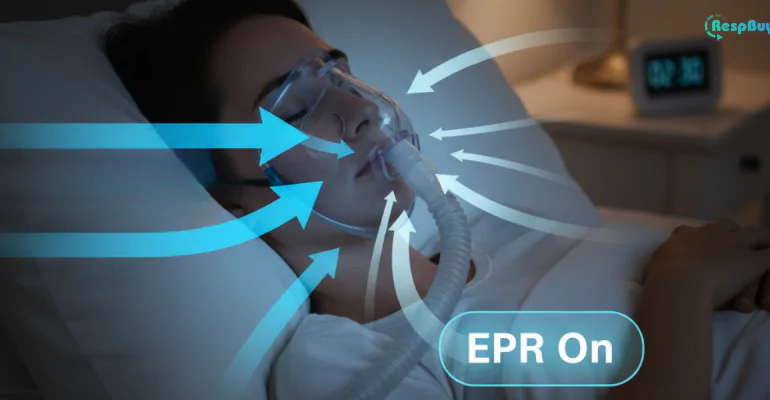What is EPR (Expiratory Pressure Relief) in CPAP Therapy?
October 24, 2025 2025-10-24 20:51What is EPR (Expiratory Pressure Relief) in CPAP Therapy?

What is EPR (Expiratory Pressure Relief) in CPAP Therapy?
If you’re new to CPAP therapy, you might have seen a setting on your device called EPR. EPR stands for Expiratory Pressure Relief. It’s a comfort feature that lowers the pressure a little bit only when you breathe out. This makes it feel more natural to breathe out and less like you’re “pushing air,” which is something that a lot of beginners feel. In short, EPR makes it easier to breathe out against the airflow, which helps you stick with therapy longer.
EPR in simple terms
CPAP therapy keeps a steady flow of pressurised air going to keep your airway open and stop apnoea events. When you turn on EPR, the machine knows when you start to exhale and lowers the pressure by a small, set amount (usually 1, 2, or 3 cmH₂O, depending on what you choose). The device goes back to the right pressure as soon as you start breathing again.
Think of it like a gentle ramp down when you breathe out and a ramp up when you breathe in. It gives you support when you need it and less when you don’t.
Who gets good out of EPR?
- People who are new to CPAP and feel “air hungry” or like they can’t breathe out.
- People who wear nasal masks or pillows and want to breathe more naturally.
- People who are sensitive to higher pressures and have aerophagia (air in the stomach), bloating, or dryness.
- When the pressure changes suddenly, EPR makes it easier for light sleepers to wake up.
Are you going to pick your first device? Check out our selection of CPAP machines here: Look through CPAP machines.
What is the difference between EPR, Ramp, and BiPAP?
- EPR (Expiratory Pressure Relief): A comfort setting that only lowers pressure during exhalation for a short time. The inhalation pressure stays at the level you set on your CPAP.
- Ramp: Starts your therapy at a lower pressure and slowly raises it over a set amount of time as you fall asleep. Ramp changes the beginning of therapy, while EPR changes every breath.
- BiPAP (BiLevel): It has two different pressures for breathing in (IPAP) and breathing out (EPAP). BiPAP is a different type of therapy that is usually given to people who need higher pressures, have certain breathing problems, or can’t handle standard CPAP.
EPR is usually all you need if your doctor has you on CPAP and you just want to feel better when you breathe out. If your doctor has told you to try bilevel therapy, talk to them about BiPAP machines.
When is it best to use (or not use) EPR?
- If you have trouble exhaling, if “puffing” against high pressure makes your mouth leak, or if you wake up a lot because of pressure discomfort, this is a good thing to use.
- If you have severe central sleep apnoea or your doctor is trying to keep your airway splinting effective by targeting a specific EPAP (exhalation) pressure, use with caution. For some users, lowering EPAP too much may make it harder to control obstructions. Always do what your sleep doctor says.
Which EPR level should I choose?
Most machines have EPR levels from 1 to 3, with 1 being the least relief and 3 being the most. A useful way to do it:
- Start at 1 for a few nights to see if you are comfortable and can control leaks.
- If it still feels hard to breathe out, go up to 2, and then 3 if you need to.
- Check your sleep again: Are you sleeping longer, waking up less, and feeling better? If so, you’re on the right track.
- If your AHI goes up or you feel like the therapy isn’t working as well, lower the EPR step or talk to your doctor.
Do you need a machine with easy-to-use EPR and comfort controls? Check out CPAP machines on RespBuy.
Helpful advice for Indian users
- Humidification is important: Our climates can be dry or humid, but a heated humidifier with EPR can help make things more comfortable by making them less dry.
- First, check the fit of the mask: When you exhale, a mask that doesn’t fit well can leak more. Before changing therapy settings, try refitting your mask.
- Keep track of your data: Newer CPAPs show how long they’ve been used, how many leaks there are, and the AHI. If you change EPR, keep an eye on your numbers for a week to see what happens.Travel and power outages: If you live in an area where power outages are common, keep a small travel CPAP or backup power supply on hand. Many travel units also have EPR-like relief to make it easier to breathe out while you’re on the go.
Important Points to Remember
- EPR makes it easier to breathe out by lowering the pressure a little bit.
- It makes you more comfortable and more likely to follow your doctor’s orders without changing the pressure you need to breathe in.
- Start with a low dose, make changes slowly, and listen to your doctor, especially if you have sleep-disordered breathing that is hard to treat.
- Make sure the machine you choose has reliable EPR and clear settings that you can change with your doctor.






